图解英语语法之时态
- 格式:ppt
- 大小:105.50 KB
- 文档页数:30
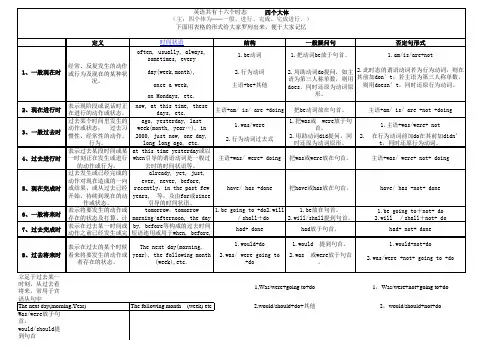
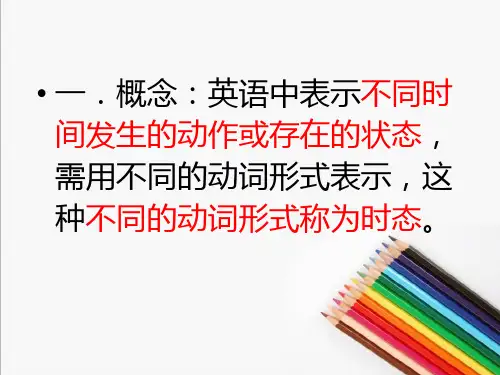
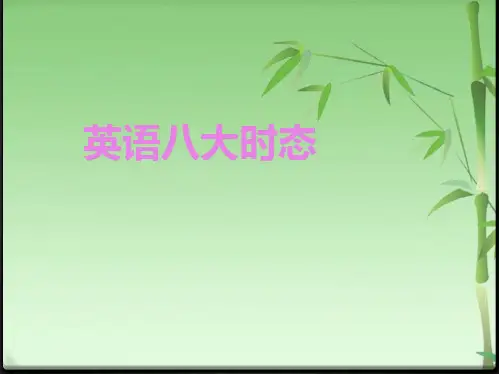

一张图搞懂英语的16个时态| 宝藏秘籍英语时态全解析一说到时态,可能很多高中生就忍不住吐槽:简直就是个磨人的小妖精!面对do,doing,did,done,had done·····一大堆长得差不多的字符,真想一把火把书烧掉!可时态作为英语的基础项,又不能丢在一遍不管不顾。
在语法体系里,时态看起来变来变去很容易混淆,其实只是因为学生的脑子里对时态还没有清晰的理解和差异化分类,在对应的语境里也就不知道该用什么时态。
理清这张图,时态其实也就那么一回事。
1一般现在时(do/does; is/am/are)①表示现在的情况、状态或特征。
例:He is a student.他是一个学生。
②表示经常性、习惯性动作。
例:He always helps others.他总是帮助别人。
③客观事实和普遍真理。
例:The earth moves the sun.地球绕着太阳转。
④表示一个按规定、计划或安排要发生的动作。
仅限于某些表示“来、去、动、停、开始、结束、继续”等的动词,可以与表示未来时间的状语搭配使用。
常见的用法是:飞机、火车、轮船、汽车等定期定点运行的交通方式。
例:The next train leaves at 3 o'clock this afternoon.下一趟火车今天下午3点开车。
⑤在时间、条件和让步状语从句中经常用一般现在(有时也用现在完成时)表示将的来事情。
(即:主将从现原则)例:I will call you as soon as I arrive at the airport.我一到机场就会给你打电话2现在进行时(am/is/are doing)① 表示此时此刻正在发生的事情。
例:He is listning to the music now.他现在正在听音乐。
② 表示目前一段时间内一直在做的事情,但不一定此时此刻正在做。
例:I am studying computer this term.这个学期我一直在学习计算机。

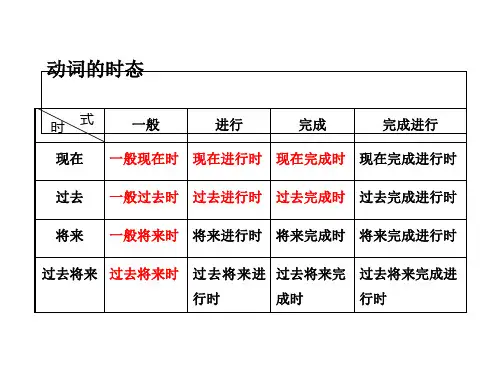

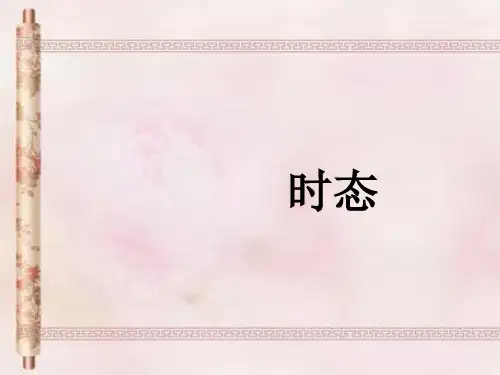

小学英语四大时态详解:五张思维导图-全小学英语主要是如下的四大时态:一般现在时、现在进行时、一般过去时、一般将来时。
一般现在时一、标志词always(总是)usually(通常)often(经常)sometimes(有时)never(从不)every(每一)二、基本用法1.表示事物或人物的特征、状态。
2.表示经常性、习惯性的动作。
3.表示客观现实。
三、构成1.be动词:主语+be动词(am isare)+其它.2.行为动词:主语+行为动词+其它。
四、句型肯定句:A. be 动词:be+主语+其它。
B. 行为动词:主语+动词(注意人称变化)+其它。
否定句:A.be动词:主语+be+not+其它。
B.行为动词:主语+助动词(do/does)+not+d动词原形+其它一般疑问句:A.be动词:be+主语+其它。
B.行为动词:助动词(Do/Does)+主语+动词原形+其他.特殊疑问词:疑问词+一般疑问句现在进行时一、标志词now(现在), look(看),listen(听)二、基本用法表示现阶段正在进行的动作三、基本结构1.肯定句:主语+be动词+动词现在分词(ing)+其它。
2.否定句:主语+be动词+not+动词现在分词(ing)+其它。
3.一般疑问句:be动词+主语+现在分词(ing)+其它。
4.特殊疑问句:疑问词+一般疑问句。
一般将来时一、标志词tomorrow(明天),soon(不久),will(将要=be going to)二、基本用法表示在在将来某个时间要发生的动作或存在的状态。
三、基本结构1.肯定句:主语+ be going to + 动词原形。
主语+will+动词原形。
2.否定句:主语+ be going to +动词原形。
主语+won’t + 动词原形3.一般疑问句:Be + 主语+ going to+动词原形Will + 主语+ 动词原形4.特殊疑问句:疑问词+一般疑问句一般过去时一、标志词yesterday(昨天),ago(以前),before(在...之前)二、用法1.表示过去某个时间发生的动作或存在的状态,常和表示过去的时间状语连用。
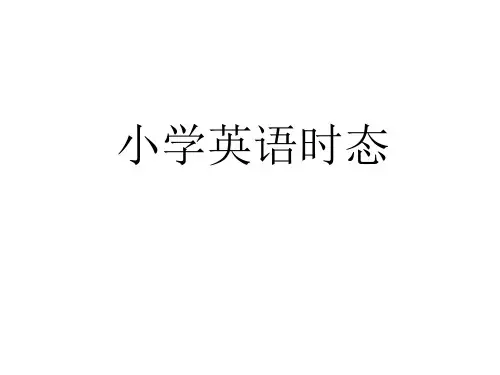
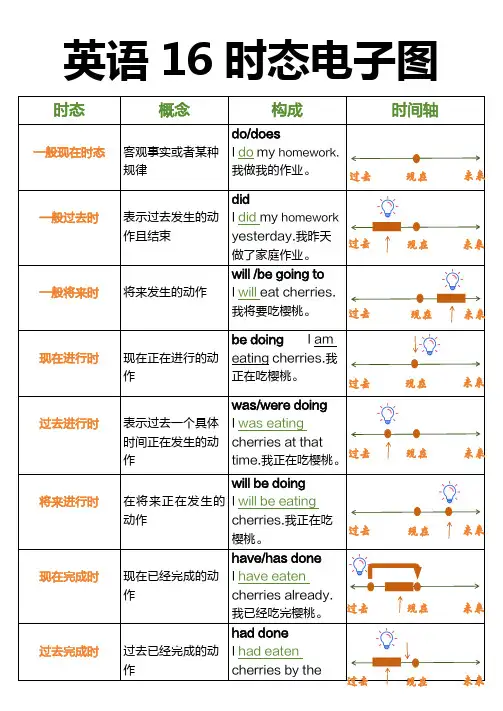
英语16时态电子图未来现在过去过去未来未来未来时态、时间现在过去将来过去将来一般时态do/does did will do Would do进行时态am/is/aredoing were/wasdoingwill be doing Would bedoing完成时态have/hasdone had done will have done Would havedone完成进行时态have beendoing had beendoingwill have beendoingWould havebeen doing二、常见时态标志词时态标志词一般现在时态every time每次in the morning早上once a week每周一次twice a month每月两次hardly ever几乎不every Sunday每个周日always总是usually通常often经常sometimes有时every day每天一般过去时ago以前yesterday昨天the day before yesterday前天last time上次last night昨晚last year去年last term上学期last Monday上周一once upon a time曾经(1)in+过去的时间过去某时in the early days在早期just now刚才一般将来时tomorrow明天the day after tomorrow后天next time下次next Friday下周五next month下个月next term下学期in+一段时间多久之后soon很快sooner or later迟早at once立刻by the end of+将来时间现在进行时look看listen听at this time此时at this moment此时at present现在right now现在过去进行时at that time在那时at that moment在那时将来进行时tomorrow,the day after tomorrow;soon;next week/month/year/...;the week/month/year现在完成时already已经yet还just刚才never从不ever曾经before以前up to now目前为止so far目前为止for+一段时间since+过去未来某一时间过去完成时by+过去时间点by the time到..时候为止by then到那时候by last time最后一次by the end of last week到了上周末before+过去时间点(3)up until+过去时间点up until then直到那时up until last time直到上次将来完成时the day after tomorrow;soon;next过去将来时the following month下个月the next time下次the next Friday 下周五the next term下学期三、被动语态主动语态被动语态一般时现在:do/does现在:be/is/are done过去:did过去:was/were done将来:will/shall do将来:will/shall be done 过去将来:would do过去将来:would be done进行时现在:am/is/are doing现在:am/is/are being done 过去:was/were doing过去:was/were being done完成时现在:have/has done现在:have/has been done过去:had done过去:had been done将来:will have done将来:will have been done过去将来:would have done过去将来:would have been done四、其他语法8类代词人称代词I、you、they、it(第一、第二、第三人称转换)物主代词my、his、their、mine、hers反身代词myself、ourselves、oneself相互代词each other、one another指示代词this、that、these、such、same疑问代词who、whom、whose、which、what关系代词who、whom、whose、which、that不定代词some、any、no、all、one、every、many、a little…8种句子结构主+谓He runs.他跑。
16张图看懂英语16大时态,全面好懂!建议收藏!
仅仅16张图就将16大时态全部理清了,每一种时态表达什么意思,在何种场合使用,使用时,有哪些固定搭配,一应俱全。
一一般现在时
二一般过去时
三一般将来时
四一般过去将来时
五现在进行时
六过去进行时
七将来进行时
八过去将来进行时
九现在完成时
十过去完成时
十一将来完成时
十二过去将来完成时
十三现在完成进行时
十四过去完成进行时
十五将来完成进行时
十六过去将来完成进行时。
135第十八章 现在完成时 什么是现在完成时?现在完成时指的是过去发生并且已经完成的动作对现在造成影响或后果,过去某一时间开始并一直持续到现在并且有可能还会持续的动作或状态。
I have finished my homework. 我已完成了作业。
(这里的finished 就是动词finish 的过去分词。
)我们和动词过去式一起来记忆吧!变化规则动词原形动词过去式动词过去分词A —A —A 型cut cut cut put put put readread read set set set hurt hurt hurt let let let shut shut shut A —B —B 型bringbrought brought buy bought bought keep kept kept A —B —B 型build built built sendsent sent spend spent spent tell told told think thought thought teachtaughttaught136变化规则动词原形动词过去式动词过去分词A —B —B 型say said said meet met met make made made A —B —C 型begin began begun drink drank drunk sing sang sung ring rang rung blow blew blown fly flew flown draw drew drawn growgrew grown drive drove driven ride rode ridden break broke breaken freeze froze frozen forget forgot forgetten eat ate eaten fall fell fallen take took taken gowent gone A —A —B 型beat beat beaten A —B —A 型come came come become became become runranrunLinda 老师的小提醒☆ 情态动词没有过去分词。
109第十四章 一般现在时 什么是一般现在时?一般现在时是表示通常性、规律性、习惯性的状态或者动作(有时间规律发生的事件)的一种时间状态。
Linda 老师的小提醒一般现在时,首先我们要清楚的是它是“现在”时的一种,表示现在这段时间内还存在或发生的状态或事情;第二关键词是“一般”, 这里的“一般”指的是在时间的发生上有一定的频率,或是一直存在,或是反复出现。
表示经常性的、反复发生的动作,常与一些时间状语连用。
I often play badminton in the afternoon.我经常在下午打羽毛球。
表示现在的状态或主语的特征、习惯、职业。
My brother is a police offi cer.我的哥哥是一名警官。
表示客观真理,也用于格言、谚语中。
Spring follows winter.冬去春来。
110这是对一种状态的描述。
I am in the classroom. 我在教室里。
(指的就是现在我的位置) He is tall. 他很高。
(指他目前的身高)We are happy. 我们很快乐。
(指现在我们的感觉)1. 基本句型: I do...(do 指代实义动词)I run every day. 我每天跑步。
I go to the park on Sundays. 我每周日去公园。
I see a flower. 我看到一朵花。
(这里的run, go, see 就是实义动词,在句中用原形。
)2. 一般疑问句: Do you...?陈述句: I see the rainbow.我看见彩虹。
一般疑问句: Do you see the rainbow? 你看到彩虹吗? 陈述句: I like my journey. 我喜欢这次旅行。
一般疑问句: Do you like your journey? 你喜欢你这次旅行吗? 陈述句: I wait here every day. 我每天等在这里。
16张图看懂英语16大时态,既全面又好懂!时态(Tense)是表示行为、动作和状态在各种时间条件下的动词形式。
因此,当我们说时态结构的时候,指的是相应时态下的动词形式。
英语时态分为16种:一般现在、一般过去、一般将来、过去将来时,以及这四者的进行时、完成时和完成进行时。
下面是16种时态的谓语动词形式和具体用法,高考必考的是前十个时态,同学们需要重点掌握。
1.一般现在时(do/does; is/am/are)①表示现在的情况、状态或特征。
例:He is a student.他是一个学生。
②表示经常性、习惯性动作。
例:He always helps others.他总是帮助别人。
③客观事实和普遍真理。
例:The earth moves the sun.地球绕着太阳转。
④表示一个按规定、计划或安排要发生的动作。
仅限于某些表示“来、去、动、停、开始、结束、继续”等的动词,可以与表示未来时间的状语搭配使用。
常见的用法是:飞机、火车、轮船、汽车等定期定点运行的交通方式。
例:The next train leaves at 3 o'clock this afternoon.下一趟火车今天下午3点开车。
⑤在时间、条件和让步状语从句中经常用一般现在(有时也用现在完成时)表示将的来事情。
(即:主将从现原则)例:I will call you as soon as I arrive at the airport.我一到机场就会给你打电话。
When you have finished the report, I will have waited for about 3 hours. 等你完成这份报告的时候,我就已经等了将近3个小时了。
2. 现在进行时(am/is/are doing)①表示此时此刻正在发生的事情。
例:He is listening to the music now.他现在正在听音乐。
②表示目前一段时间内一直在做的事情,但不一定此时此刻正在做。